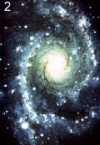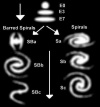Galaxy Structure
Home |
Star Fleet Library |
BuPers |
SF Engineering |
SF Intelligence |
SF JAG |
SF Marine Corps |
SF Medical |
SF Records |
SF Sciences
UFP Dept. of Colonial Affairs |
UFP Educational, Scientific and Cultural Org.
Introduction
Any galaxy can be generally divided in to a number of seperate parts with distinct features. There are a number of types of Galaxy as well.
Galaxy Types
Bulge (1)There are billions of stars in the bulge, packed closely together. They follow various orbits around the center of the Bulge, and these orbits can often be very ecentric. The Bulge varies tremendously in size with comparison to the disk. Sometimes in a galaxy the Bulge can vitually swallow the disk, other times it is small in comparison. Generally the stars in the bulge are very old (up to 15 billion years) and were formed when the galaxy was formed. Disk (2)Composed mainly of bright blue new stars, the disk is a vast flat plane where new stars are formed. Some of these stars are so big they don't even survive one orbit of the Bulge. Unlike the Bulge which is virtually free of intersteller dust, the disk has vast quantities of star making material which where it gets its patterned 'dense' appearance. The disk is usually fairly thin, only 1/100 of its diameter. Tilted Disk (3)At an angle of approximetely 20 degrees off the plane of the main disk, the tilted disk is within the Bulge, and rotates seperaterly from the main disk. Globular Cluster (4)Globular clusters are outside of the disk and the Bulge. They are groups of stars. They have very eccentric orbits around the center of the galaxy. They form what is called the halo of the galaxy, like a huge sphere that holds the disk and bulge. Mostly the clusters orbit within the halo, but occasionally the cluster orbit hundreds of thousands of light years out of the halo (these rogue clusters are known as intergalactic tramps). |
Galaxy Formation
| Galaxies generally start life as featureless collections of stars known as Ellipticals. They then slowly form a disk (1) as they begin to flatten. At this point, one of two things can happen. Firstly a galaxy can become a Spiral Galaxy (2) or secondly a galaxy becomes a Barred Spiral Galaxy (3). The diagram below illustrates this process of galaxy formation (known as Hubble's Galactic Species). It can take billions of years for a mature galaxy to develop, each stage taking very roughly 200 million years...
Note the black line through the center indicates the disk of the galaxy that is dense with star-making dust and gas. As the ellipical develops this disk becomes more definite and a lot thinner. |
Galaxy Development
| Ellipticals are classed as E0 to E7, depending on their stage of development. The point where a galaxy can become a barred spiral or a spiral galaxy is known as SO. A barred spiral galaxy is classed as SBa, SBb or SBc depending on its particular shape and development. A spiral galaxy is classed Sa, Sb or Sc depending on its shape and stage of development. Galaxies can take on many different shapes and forms, often caused by the fact that sometimes galaxies pass each other and the gravitational pull distorts them. In some cases galaxies collide, called a merger, this event creates new ellipticals. |
Additional Information
For additional information see: Star Structure
Disclaimer
This material was developed for use in ASR and is not intended to apply anywhere outside ASR. You are welcome to bookmark our pages and view them repeatedly without being a player in ASR. No other use of the material contained within the ASR Manual- including copying or altering any of the pages within for one's own use- is permitted. For further information about joining ASR, please click here.


